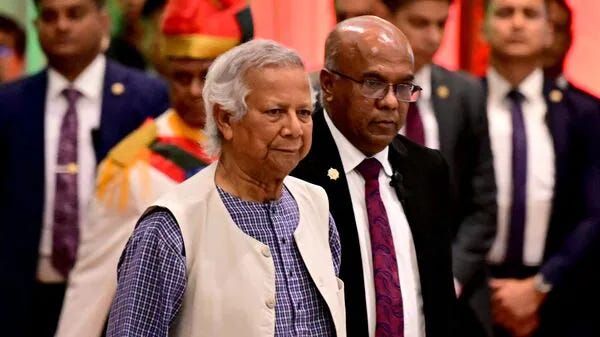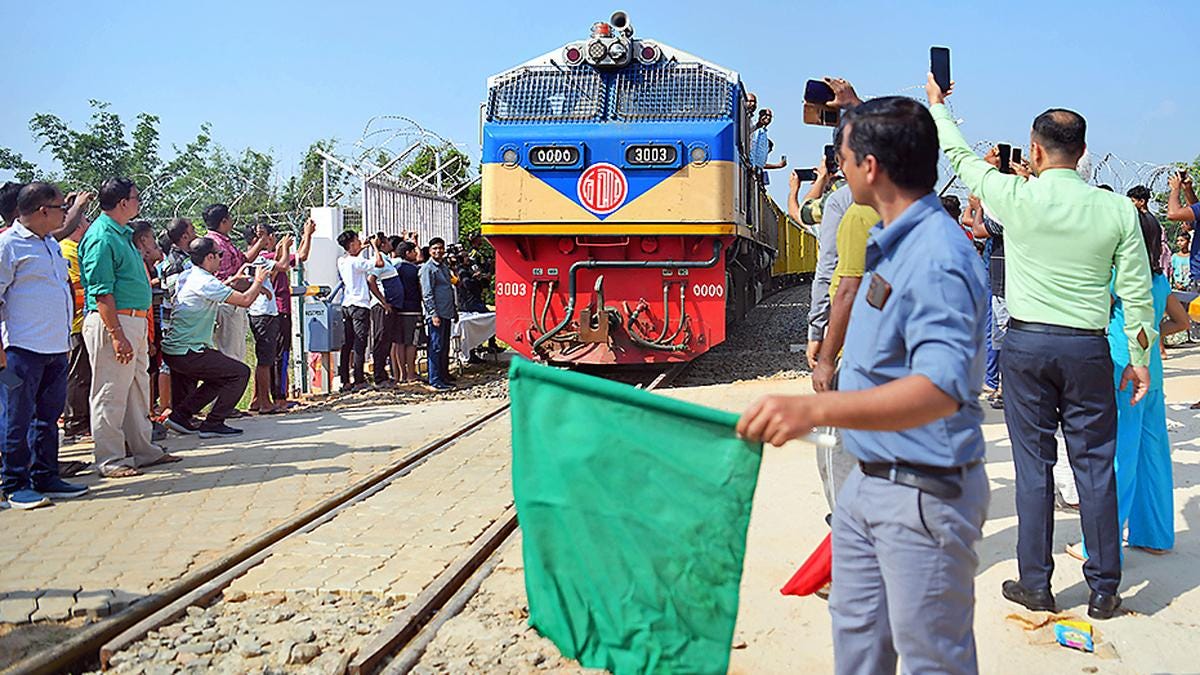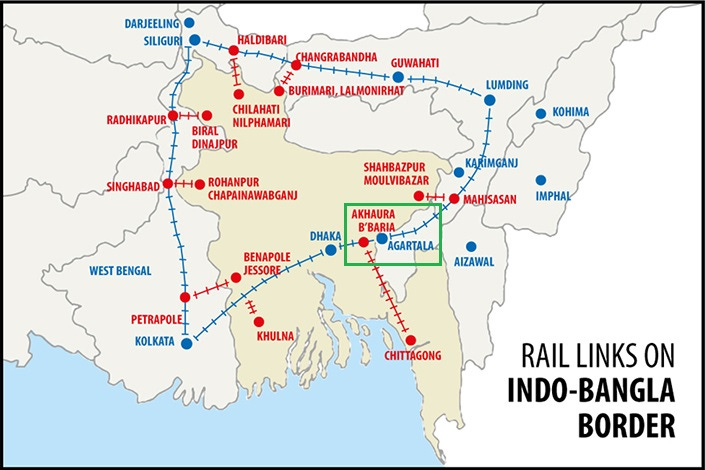Regime Change in Bangladesh: National Security and Developmental Implications for India
Apart from concerns about the safety of Hindus, India should be focused on the possibility of ULFA leaders, who already enjoy support from China, finding a safe haven in the Chittagong Hill Tract.

Regime Change in Bangladesh: Implications for India
The recent political upheaval in Bangladesh, marked by the ouster of Prime Minister Sheikh Hasina and the swearing-in of Nobel laureate Muhammad Yunus as the Interim Chief Coordinator, presents significant challenges and opportunities for India. While mainstream Indian media and right-wing social media influencers have largely focused on the potential threat to the Hindu minority, including its temples, in Bangladesh, the more pressing—and far less discussed—concerns for India involve broader national security implications. These include the risk of insurgent groups like the ULFA and Naga rebels potentially finding a safe haven in Bangladesh, as well as the growing influence of China in the region.
Additionally, the successful execution of critical projects like the Kaladan Multi-Modal Transit Transport Project and the Akhaura-Agartala Rail Link, which are vital for the development and strategic interests of India's Northeast, hinges on continued cooperation with Bangladesh.
National Security Implications
Paresh Baruah, the self-styled commander-in-chief and vice-chairperson of the United Liberation Front of Assam - Independent (ULFA-I), is a central figure in this emerging threat. ULFA-I, a banned militant organisation seeking to establish an independent sovereign state of Assam, has long been a destabilising force in Northeast India. Baruah is believed to be operating from neighbouring Myanmar, under the patronage of China, making the current instability in Bangladesh a potential catalyst for a resurgence of insurgent activities in the region. The prospect of these groups finding renewed support and sanctuary in Bangladesh, particularly in the Chittagong Hill Tracts (CHT) region, is a significant concern for India's security and regional stability.
Safety and Security of Hindu Minorities
The concern for the safety of Hindus in Bangladesh is not without merit, given their status as a vulnerable minority. Bangladesh, with an estimated population of 17.47 crores, has approximately 1.31 crores of Hindus, comprising 7.5% of the population in the country whereas Muslims constitute an overwhelming 91% majority. Isolated incidents of arson targeting Hindu families and temples have received disproportionate media coverage in India, fuelling fears of a potential rise in communal violence, with reminder of the horrors of the partition in 1947. However, there have been no reports of large-scale genocidal attacks on Hindus since the regime change, indicating that the situation, while tense, is not yet catastrophic.
Muhammad Yunus, in his initial statements as Interim Chief Coordinator, has sought to reassure both domestic and international audiences that the safety of minorities will be a priority under his administration. He has emphasized that a true democracy in Bangladesh would inherently safeguard minority rights, drawing a parallel to the democratic structures in India where minorities— both linguistic and religious— are specially protected under the Constitution of India. This stance suggests that while the Hindu community in Bangladesh may face challenges, there is potential for their situation to stabilize under the new regime.
The Real Threat: Insurgent Groups and China's Influence
While the safety of Hindu minorities is a critical issue, the more immediate and strategic concern for India is the potential resurgence of insurgent groups like the United Liberation Front of Asom (ULFA) and Naga rebels. The porous Indo-Bangladesh border, particularly in the Chittagong Hill Tracts (CHT) region, could become a haven for these groups, undermining India's efforts to maintain peace and tranquility in the Northeast, should the India-Bangladesh relations turn sour, even if not hostile.
Paresh Baruah, the leader of ULFA, is reportedly based in Ruili, Yunnan Province, China, operating along the China-Myanmar border. Given the current instability in Bangladesh, there is a significant risk that ULFA and other insurgent groups could find renewed support and sanctuary within Bangladesh, particularly in areas like the Chakma Hills. This development could destabilize India's northeastern states and strain Indo-Bangladesh relations, complicating India's efforts to counter these emerging threats.
Moreover, China's influence in Bangladesh is a growing concern. With substantial investments under the Belt and Road Initiative and significant trade ties, China has considerable leverage over Dhaka. The regime change could potentially tilt Bangladesh closer to China, especially if the new administration perceives India as unsupportive or hostile. This shift could have far-reaching implications for India's security and its strategic interests in the region.
Strategic Connectivity Initiatives: Strengthening India's Northeastern Access and Regional Ties
The Kaladan Multi-Modal Transit Transport Project and the Akhaura-Agartala Rail Link are two pivotal connectivity initiatives that significantly bolster India's access to its northeastern states while also strengthening ties with neighbouring countries.
The Kaladan project links the eastern Indian seaport of Kolkata with Sittwe port in Myanmar through a combination of sea, river, and road transport, providing an alternate route to India's landlocked northeastern states by bypassing the narrow Siliguri Corridor. This initiative reduces the distance from Kolkata to Mizoram by approximately 1,000 km, thereby enhancing regional connectivity.
Meanwhile, the Akhaura-Agartala Rail Link directly connects Agartala in Tripura with Akhaura in Bangladesh. This 12.24 km rail line dramatically cuts the travel time between Kolkata and Agartala from 31 hours to about 10 hours, reducing the distance from 1,600 km to 500 km.
These projects are vital for India as they improve connectivity to the northeastern states, reduce transportation costs and time, boost economic development in the region, and enhance strategic access and influence. Crucially, successful implementation and operation of these projects require cooperation from Bangladesh, underscoring the importance of strong India-Bangladesh relations in achieving these connectivity goals.
India’s Diplomatic Response
India's response to the regime change in Bangladesh needs to be both measured and strategic. Prime Minister Narendra Modi's congratulatory message to Muhammad Yunus, along with a call to safeguard the safety and protection of Hindus and other minority communities, is a positive gesture that signals India's readiness to engage constructively with the new administration. However, this engagement must be supported by a nuanced understanding of the complex dynamics involved.
India should focus on building a relationship with the new Bangladeshi leadership based on mutual respect and strategic cooperation, rather than remaining emotionally tied to a regime that has been consigned to history by the people of Bangladesh. This approach involves addressing security concerns related to insurgent groups while also working to counterbalance China's growing influence in the region. It is essential that the Ministry of External Affairs (MEA) carefully considers all of India's strategic interests, particularly the potential for ULFA and Naga rebels to find sanctuary in Bangladesh if the new regime adopts an anti-India stance under external pressures. Additionally, India must continue to advocate for the protection of Hindu minorities in Bangladesh, not only as a moral obligation but also to prevent the escalation of communal tensions that could spill over into India.
U.S. Influence in Bangladesh: A Strategic Challenge and Opportunity for India
It is widely acknowledged that the United States, both directly and through American NGOs such as USAID, the National Endowment for Democracy (NED), and Freedom House, actively worked against the Sheikh Hasina regime in Bangladesh, favouring opposition forces. Last year, the US extended its support to the Islamist Bangladesh Nationalist Party (BNP) and its jihadist ally, Jamaat-e-Islami, during their protests against Prime Minister Hasina's government. The US and other Western countries persistently pressured the Awami League government to step down, hand over power to a caretaker regime, and release all jailed BNP and Jamaat leaders to ensure what they termed 'free and fair' elections. Despite this international pressure, both India and China, setting aside their own disputes, backed Sheikh Hasina, enabling her to withstand US influence and secure a fifth term in power.
With the recent regime change in Bangladesh, the United States is likely to intensify efforts to establish its sphere of influence in the country, aiming to counteract the significant presence of China in the region. India can leverage this shift to forge a new plank of Indo-US collaboration, not only to safeguard its national security concerns, particularly regarding the Naga rebel issue, but also to ensure the successful execution of strategically important projects like the Kaladan Multi-Modal Transit Transport Project and the Akhaura-Agartala Rail Link. This collaboration could serve as a vital tool for India to maintain and enhance its influence in this strategically located country.

Looking Forward: Risks and Opportunities for India
The regime change in Bangladesh presents both challenges and opportunities for India, with stakes that are particularly high given the two countries' shared 4,096-kilometre border, much of which is not adequately policed. While the safety of Hindu minorities in Bangladesh is a significant concern, the broader strategic implications related to insurgent groups, particularly the potential for Naga rebels to find a safe haven, and the renewed influence of the United States, must form an important strand of India's diplomatic approach. This approach must prioritize safeguarding India's national security interests and ensuring the successful execution of critical corridor projects, while fostering a stable and cooperative relationship with the new Bangladeshi regime. Achieving this will require a delicate balancing act, carefully considering both domestic and regional factors to protect India's interests in the region, as well as in our own Northeast.
Acknowledgements: Special thanks to our friend and batchmate, Ramesh Negi of the AGMUT Cadre, 1984 batch, would spent many years of service in the northeast, including as the Chief Secretary of Arunachal Pradesh.
Citations
[1] https://en.wikipedia.org/wiki/United_Liberation_Front_of_Asom
[2] https://military-history.fandom.com/wiki/Paresh_Baruah
[3] https://theprint.in/india/truth-about-ulfa-my-childhood-why-ill-keep-fighting-rebel-paresh-baruah-on-his-memoir/637059/
[4] https://economictimes.indiatimes.com/topic/paresh-baruah
[5] https://thediplomat.com/2024/01/outlawed-ulfa-faction-signs-agreement-with-indian-government/
[6] https://www.thehindu.com/news/national/understanding-the-peace-pact-with-ulfa-explained/article67703481.ece
[7] https://timesofindia.indiatimes.com/india/ulfa-i-operating-from-base-in-china-centre-tells-tribunal/articleshow/78471000.cms
[8] https://economictimes.indiatimes.com/news/defence/paresh-baruah-tries-to-revive-ulfa/articleshow/111026309.cms
[9] https://apnews.com/article/india-ulfa-rebels-assam-peace-accord-94dbded44cd992f08adf4f437f7c13f3
[10] https://www.satp.org
[11] https://www.timesofassam.com/headlines/verdict-arms-smuggling-ulfa-questions-bangladesh-sovereignty/
[12] https://www.eurasiareview.com/19042022-india-worrying-spike-in-northeast-analysis/
[13] https://abcnews.go.com/International/wireStory/ouster-bangladeshs-prime-minister-test-indias-regional-power-112634903
[14] https://foreignpolicy.com/2024/08/06/bangladesh-hasina-protests-resignation-modi-india-china/
[15] https://thediplomat.com/2024/08/new-delhis-concerns-mount-with-sheikh-hasinas-exit/
[16] https://thesoufancenter.org/intelbrief-2024-august-8/







